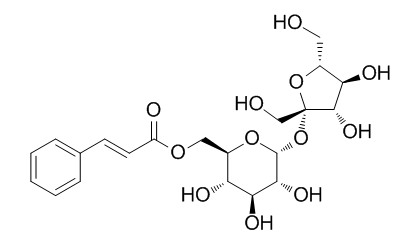Sibirioside A
Reference standards.
Inquire / Order:
manager@chemfaces.com
Technical Inquiries:
service@chemfaces.com
Tel:
+86-27-84237783
Fax:
+86-27-84254680
Address:
1 Building, No. 83, CheCheng Rd., Wuhan Economic and Technological Development Zone, Wuhan, Hubei 430056, PRC
Providing storage is as stated on the product vial and the vial is kept tightly sealed, the product can be stored for up to
24 months(2-8C).
Wherever possible, you should prepare and use solutions on the same day. However, if you need to make up stock solutions in advance, we recommend that you store the solution as aliquots in tightly sealed vials at -20C. Generally, these will be useable for up to two weeks. Before use, and prior to opening the vial we recommend that you allow your product to equilibrate to room temperature for at least 1 hour.
Need more advice on solubility, usage and handling? Please email to: service@chemfaces.com
The packaging of the product may have turned upside down during transportation, resulting in the natural compounds adhering to the neck or cap of the vial. take the vial out of its packaging and gently shake to let the compounds fall to the bottom of the vial. for liquid products, centrifuge at 200-500 RPM to gather the liquid at the bottom of the vial. try to avoid loss or contamination during handling.
Food Chem.2024, 458:140201.
SCOPUS.2020, 836-847.
Int J Vitam Nutr Res.2022, doi: 10.1024.
Cell.2022, 185(23):4298-4316.e21.
Food Chemistry: X.2022, 2022.100270
Evid Based Complement Alternat Med.2017, 2017:1401279
Cell Physiol Biochem.2019, 52(6):1255-1266
Research Square2024, rs-4398438
Molecules.2021, 26(4):816.
Sci Rep. 2018, 10590
Related and Featured Products
J Pharm Biomed Anal. 2011 Dec 5;56(4):830-5.
Development of an in-line HPLC fingerprint ion-trap mass spectrometric method for identification and quality control of Radix Scrophulariae.[Pubmed:
21839598]
Chromatographic fingerprinting has been widely accepted as a crucial method for qualitative and quantitative analyses of bioactives within traditional Chinese medicine. A fingerprint provides detailed information, specific for any given herb, thus facilitating the quality control measures of a given traditional Chinese medicine.
METHODS AND RESULTS:
In this article, quality assessment of Radix Scrophulariae was achieved by using high performance liquid chromatography combining diode-array detection and electrospray ionization mass spectrometry (HPLC-DAD-ESI/MS). Eight batches of sample obtained from different origins in China were used to establish the fingerprint and quantitative analyses. By comparing the retention times, UV and MS spectral data with reference standards, four characteristic peaks in the chromatograms were confirmed as corresponding to acetoside, angoroside C, cinnamic acid, and harpagoside. In addition, other two characteristic peaks were tentatively identified, following the literature interpretation of HPLC-ESI-MS and LC-MS/MS (affording structural information) to be Sibirioside A and scrophuloside B(4), respectively.
CONCLUSIONS:
The results indicated that the newly developed HPLC-DAD-MS fingerprint method would be suitable for quality control of Radix Scrophulariae.
Phytochemistry. 2000 Aug;54(8):923-5.
Phenylpropanoid glycosides from Scrophularia ningpoensis.[Pubmed:
11014290]
METHODS AND RESULTS:
Three phenylpropanoid glycosides named ningposides A (3-O-acetyl-2-O-feruloyl-alpha-L-rhamnopyranose), B (4-O-acetyl-2-O-feruloyl-alpha-L-rhamnopyranose) and C (3-O-acetyl-2-O-p-hydroxycinnamoyl-alpha-L-rhamnopyranose) along with the known compounds Sibirioside A, cistanoside D, angoroside C, acteoside, decaffeoylacteoside and cistanoside F were obtained from the roots of Scrophularia ningpoensis.



